Ultra-Short-Term Wind Power Prediction with Multi-Scale Feature Extraction Under IVMD
Abstract
1. Introduction
1.1. Motivation
1.2. Literature Review
1.3. Main Contributions
- (1)
- MIC-driven feature selection identifying key meteorological predictors.
- (2)
- Entropy-guided adaptive VMD via SSA-tuned decomposition parameters.
- (3)
- Multiscale hybrid forecasting integrating mode-feature fusion and SSA-optimized TCN-BiGRU architecture.
1.4. Paper Organization
2. Overall Construction Based on IVMD and Multi-Scale Feature Extraction Model
- MIC feature dimension reduction. The original data contains some meteorological features with weak correlation with wind power; eliminating redundant meteorological features can not only reduce the input dimension of the model, but also improve the model’s generalization ability [26].Compared to traditional methods like Pearson’s correlation analysis, MIC can evaluate correlations for both linear and nonlinear relationships, offering broad universality and equitability. The MIC calculation formula is as follows:where denotes the mutual information between variables and ; represents the joint probability distribution of and ; and are the marginal probability distributions of and , respectively; and are the number of cells for each axis in performing the scatter-grid distribution, respectively; and is approximately 0.6 times the sample size.
- The raw wind power sequences were subjected to signal decomposition and denoising preprocessing. To address the randomness of wind power, the IVMD method was employed to adaptively decompose and denoise the original wind power signal, yielding a set of relatively smooth components, denoted as .
- Data preprocessing and division. To mitigate the influence of differing dimensions on prediction results, each component is first individually integrated with key meteorological features before undergoing uniform normalization, as defined in Equation (2). The processed datasets were then partitioned into training and testing subsets.where and are the data before and after normalization, respectively; and are the maximum and minimum values of the data columns, respectively.
- Prediction model construction. The training set data are input into the TCN-BiGRU framework for model training, while the optimal parameter combinations are obtained by iterative tuning using SSA, and the optimized model is applied to the test set data, after which the prediction results of each component are output.
- Error evaluation analysis. The wind power prediction value is obtained by superimposing the inverse normalization of each component, and the prediction results are analyzed according to the error evaluation indexes and comparison models to quantitatively determine the performance of the model. To impartially assess model efficacy, three established metrics are employed: root mean square error (RMSE), mean absolute error (MAE), and coefficient of determination . These quantify forecasting precision through the following formulations:where S denotes the total sample count; and represent the actual and forecasted values for the i-th sample, respectively; and indicates the mean of .
3. Wind Power Data Decomposition Based on IVMD
3.1. Processing of Non-Stationary Wind Power Signals
3.2. Principle Explanation of IVMD
- Perform phase space reconstruction for a given time series and denote each reconstructed component as follows:where denotes the embedding dimensionality; indicates the count of delay times; and the number of reconstruction components is .
- The elements in each reconstructed component after sorting in ascending numerical order:where is the column number of the reconstructed component before sorting. Therefore, the m-dimensional component can be mapped to different , with a total of sorting modes.
- Denote by the probability of occurrence of different sorting patterns and satisfy . The entropy of the arrangement of the time series can be expressed as follows:
3.3. Overall Construction of IVMD
- Initialize the and parameters to find the optimal range, set the number of sparrow populations with the maximum number of iterations, and use permutation entropy as the fitness function.
- For each sparrow’s current position , use VMD to decompose in terms of and to obtain IMFs, calculate the permutation entropy value of each IMF component, and record the value of the minimum and maximum fitness at this point and its corresponding parameter combination method.
- Upon completion of a single iteration, the fitness values of all parameter combinations are reassessed. The positional information of explorers, followers, and vigilantes is dynamically updated, while the current global optimal and suboptimal fitness values—along with their corresponding parameter combinations—are synchronously propagated across the system.
- When the preset maximum number of iterations or the convergence threshold of the fitness function is reached, the optimal parameter combination is output; otherwise, return to step 2 to continue the iterative calculation.
- Perform VMD modal decomposition of the raw wind power signal using the optimized parameter configuration.
4. Design of Multiscale Feature Extraction Prediction Models
4.1. Temporal Convolutional Neural Networks
4.2. Bidirectional Gated Recurrent Units
4.3. Hyperparameter Optimization of Multiscale Feature Extraction Models
5. Simulation Analysis
5.1. Data Preparation and Correlation Analysis
5.2. Model Parameter Settings
5.3. Analysis of Ablation Experiment Results
5.4. Analysis of the Results of Comparative Experiments
5.5. Model Generalization Performance Analysis
6. Conclusions
- The IVMD method adaptively decomposes raw wind power sequences into multiple distinct frequency-band components, significantly reducing the complex non-stationary characteristics in wind power data. This approach reduces and by 14.94% and 30.88%, respectively, compared to non-adaptive benchmark methods in prediction tasks.
- Within the constructed TCN-BiGRU multiscale feature extraction framework, the TCN captures global trend features through its dilated causal convolution architecture. Concurrently, the BiGRU extracts local detail information via gated recurrent units. Following SSA optimization, the model’s adaptability is further enhanced.
- Ablation studies demonstrate the critical contributions of each module in the proposed framework, while comparative experiments against three benchmark models confirm its superior performance across all error metrics. These findings substantiate significant deployment potential for ultra-short-term wind power forecasting.
Author Contributions
Funding
Data Availability Statement
Conflicts of Interest
References
- Shu, Y.; Zhao, Y.; Zhao, L.; Qiu, B.; Liu, M.; Yang, Y. Study on Low Carbon Energy Transition Path Toward Carbon Peak and Carbon Neutrality. Proc. CSEE 2023, 43, 1663–1671. [Google Scholar] [CrossRef]
- Chen, H.; Li, H.; Kan, T.; Zhao, C.; Zhang, Z.; Yu, H. DWT-DTCNA Ultra-short-term Wind Power Prediction Considering Wind Power Timing Characteristics. Power Syst. Technol. 2023, 47, 1653–1662. [Google Scholar] [CrossRef]
- Du, P.; Yang, D.; Li, Y.; Wang, J. An innovative interpretable combined learning model for wind speed forecasting. Appl. Energy 2024, 358, 122553. [Google Scholar] [CrossRef]
- Shi, J.; Wang, B.; Luo, K.; Wu, Y.; Zhou, M.; Watada, J. Ultra-short-term wind power interval prediction based on multi-task learning and generative critic networks. Energy 2023, 272, 127116. [Google Scholar] [CrossRef]
- Hu, Y.; Zhu, L.; Li, J.; Li, Y.; Zeng, Y.; Zheng, L.; Shuai, Z. Short-term wind power forecasting with the integration of a deep error feedback learning and attention mechanism. Power Syst. Prot. Control 2024, 52, 100–108. [Google Scholar] [CrossRef]
- Gong, M.; Yan, C.; Xu, W.; Zhao, Z.; Li, W.; Liu, Y.; Li, S. Short-term wind power forecasting model based on temporal convolutional network and Informer. Energy 2023, 283, 129171. [Google Scholar] [CrossRef]
- Guo, N.-Z.; Shi, K.-Z.; Li, B.; Qi, L.-W.; Wu, H.-H.; Zhang, Z.-L.; Xu, J.-Z. A physics-inspired neural network model for short-term wind power prediction considering wake effects. Energy 2022, 261, 125208. [Google Scholar] [CrossRef]
- Su, X.; Zhu, M.; Yu, H.; Li, C.; Fu, Y.; Mi, Y. Ultra-short-term probabilistic forecasting of offshore wind power based on spectral attention and non-crossing joint quantile regression. Power Syst. Prot. Control 2024, 52, 103–116. [Google Scholar] [CrossRef]
- Xian, H.; Che, J. Unified whale optimization algorithm based multi-kernel SVR ensemble learning for wind speed forecasting. Appl. Soft Comput. 2022, 130, 109690. [Google Scholar] [CrossRef]
- Hua, L.; Zhang, C.; Peng, T.; Ji, C.; Nazir, M.S. Integrated framework of extreme learning machine (ELM) based on improved atom search optimization for short-term wind speed prediction. Energy Convers. Manag. 2022, 252, 115102. [Google Scholar] [CrossRef]
- Lv, Y.; Hu, Q.; Xu, H.; Lin, H.; Wu, Y. An ultra-short-term wind power prediction method based on spatial-temporal attention graph convolutional model. Energy 2024, 293, 130751. [Google Scholar] [CrossRef]
- Zhu, Q.; Li, J.; Qiao, J.; Shi, M.; Wang, C. Application and Prospect of Artificial Intelligence Technology in Renewable Energy Forecasting. Proc. CSEE 2023, 43, 3027–3047. [Google Scholar] [CrossRef]
- Kırat, O.; Çiçek, A.; Yerlikaya, T. A new artificial intelligence-based system for optimal electricity arbitrage of a second-life battery station in day-ahead markets. Appl. Sci. 2024, 14, 10032. [Google Scholar] [CrossRef]
- Sun, Y.; Zhou, Q.; Sun, L.; Sun, L.; Kang, J.; Li, H. CNN–LSTM–AM: A power prediction model for offshore wind turbines. Ocean Eng. 2024, 301, 117598. [Google Scholar] [CrossRef]
- Shahid, F.; Zameer, A.; Muneeb, M. A novel genetic LSTM model for wind power forecast. Energy 2021, 223, 120069. [Google Scholar] [CrossRef]
- Harbola, S.; Coors, V. One dimensional convolutional neural network architectures for wind prediction. Energy Convers. Manag. 2019, 195, 70–75. [Google Scholar] [CrossRef]
- Zang, H.; Zhao, Y.; Zhang, Y.; Cheng, L.; Wei, Z.; Qin, X. Ultra-short-term Wind Power Prediction Based on Power Correction Under Low Wind Speed and Improved Loss Function. Autom. Electr. Power Syst. 2024, 48, 248–257. [Google Scholar] [CrossRef]
- Chen, H.; Zhou, Y.; Wang, C.; Wang, J.; Han, H.; Lü, X. Economic Analysis of System Spinning Reserve Based on Improved CNN-LSTM Short Term Wind Power Prediction. High Volt. Eng. 2022, 48, 439–446. [Google Scholar] [CrossRef]
- Chang, Y.; Yang, Z.; Pan, F.; Tang, Y.; Huang, W. Ultra-short-term Wind Power Prediction Based on CEEMDAN-PE-WPD and Multi-objective Optimization. Power Syst. Technol. 2023, 47, 5015–5025. [Google Scholar] [CrossRef]
- Xiao, Y.; Zou, C.; Chi, H.; Fang, R. Boosted GRU model for short-term forecasting of wind power with feature-weighted principal component analysis. Energy 2023, 267, 126503. [Google Scholar] [CrossRef]
- Yu, M.; Niu, D.; Gao, T.; Wang, K.; Sun, L.; Li, M.; Xu, X. A novel framework for ultra-short-term interval wind power prediction based on RF-WOA-VMD and BiGRU optimized by the attention mechanism. Energy 2023, 269, 126738. [Google Scholar] [CrossRef]
- Liu, T.; Qiao, X.; Jian, L.; Jin, C.; Sun, K. TCN Short-term Wind Power Prediction by Introducing Attention Mechanism and Parameter Optimization. Proc. CSU-EPSA 2024, 36, 88–95. [Google Scholar] [CrossRef]
- Wu, Y.-K.; Huang, C.-L.; Wu, S.-H.; Hong, J.-S.; Chang, H.-L. Deterministic and probabilistic wind power forecasts by considering various atmospheric models and feature engineering approaches. IEEE Trans. Ind. Appl. 2022, 59, 192–206. [Google Scholar] [CrossRef]
- Wang, Y.; Shi, Y.; Zhou, X.; Zeng, Q.; Fang, B.; Bi, Y. Ultra-short-term Power Prediction for BiLSTM Multi Wind Turbines Based on Temporal Pattern Attention. High Volt. Eng. 2022, 48, 1884–1892. [Google Scholar] [CrossRef]
- Liu, X.; Pu, X.; Li, J.; Zhang, J. Short-term wind power prediction of a VMD-GRU based on Bayesian optimization. Power Syst. Prot. Control 2023, 51, 158–165. [Google Scholar] [CrossRef]
- Zheng, K.; Miao, X.; Lin, Y.; Huang, C. Phase sequence identification method for users in low-voltage transform district with photovoltaic based on maximal information coefficient. Electr. Power Autom. Equip. 2024, 44, 108–114. [Google Scholar] [CrossRef]
- Wang, R.; Xu, X.; Lu, J. Short-term Wind Power Prediction Based on SSA Optimized Variational Mode Decomposition and Hybrid Kernel Extreme Learning Machine. Inf. Control 2023, 52, 444–454. [Google Scholar] [CrossRef]
- Wang, Q.; Liu, H.; Nie, Z. Two-stage short-term load forecasting based on VMDT-POA-DELM-GPR. Foreign Electron. Meas. Technol. 2024, 43, 101–109. [Google Scholar] [CrossRef]
- Wang, H.; Zou, Z.; Li, X.; Wu, Z.; Zhou, K. Short-term wind power prediction based on VMD-ISSA-GRU comprehensive model. Therm. Power Gener. 2024, 53, 122–131. [Google Scholar] [CrossRef]
- Yu, W.; Zhu, R.; Chen, X.; Shang, J.; Bai, X.; Wang, H. Phase Sequence Identification Method for Low-Voltage Distribution Stations Area Based on Dual-Scale Similarity and Improved DBSCAN Algorithm. Electr. Power Constr. 2024, 45, 74–88. [Google Scholar] [CrossRef]
- Zhao, L.; Liu, Y.; Shen, X.; Liu, D.; Lü, S. Short-term wind power prediction model based on CEEMDAN and an improved time convolutional network. Power Syst. Prot. Control 2022, 50, 42–50. [Google Scholar] [CrossRef]
- Liu, S.; Xu, T.; Du, X.; Zhang, Y.; Wu, J. A hybrid deep learning model based on parallel architecture TCN-LSTM with Savitzky-Golay filter for wind power prediction. Energy Convers. Manag. 2024, 302, 118122. [Google Scholar] [CrossRef]
- Wang, S.; Shi, J.; Yang, W.; Yin, Q. High and low frequency wind power prediction based on Transformer and BiGRU-Attention. Energy 2024, 288, 129753. [Google Scholar] [CrossRef]
- Ni, J.; Zhang, J. Short-term forecasting of integrated energy load in TCN-BiGRU based on multi-task bi-level attention optimization. Control Eng. China 2024, 31, 1924–1936. [Google Scholar] [CrossRef]
- Li, L.; Gao, G.; Wu, W.; Wei, Y.; Lu, S.; Liang, J. Short-term Day-ahead Wind Power Prediction Considering Feature Recombination and Improved Transformer. Power Syst. Technol. 2024, 48, 1466–1476. [Google Scholar] [CrossRef]
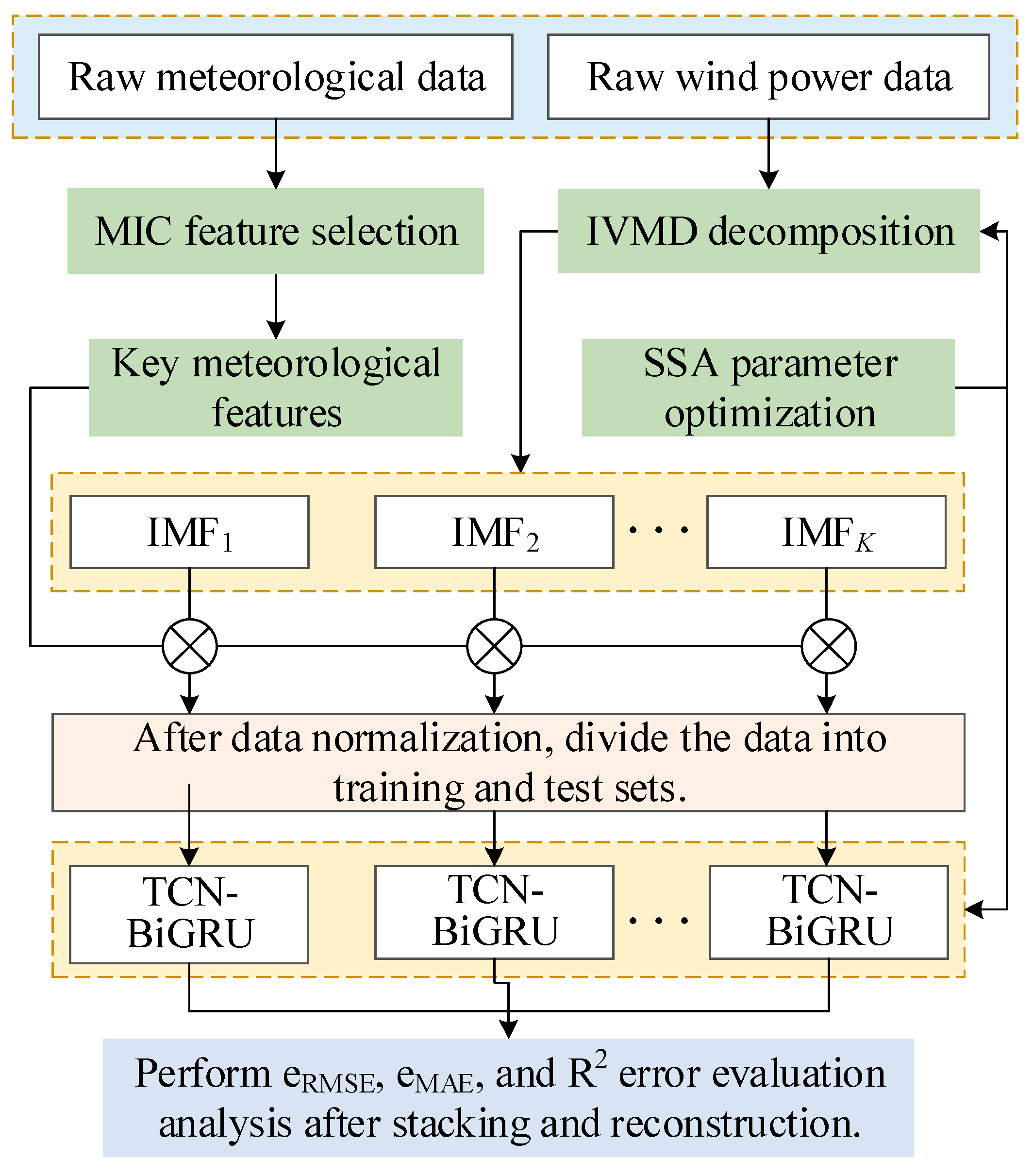
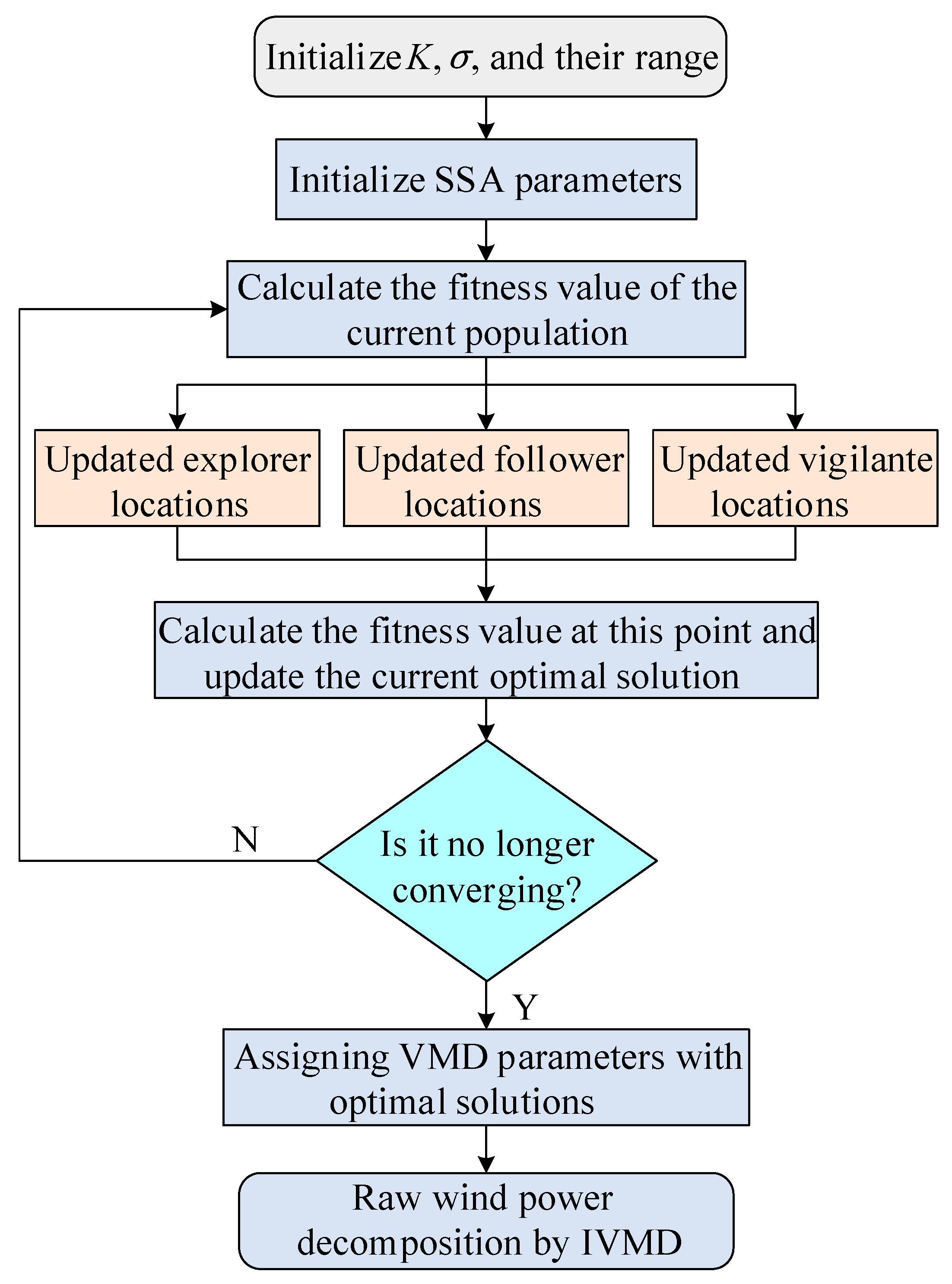

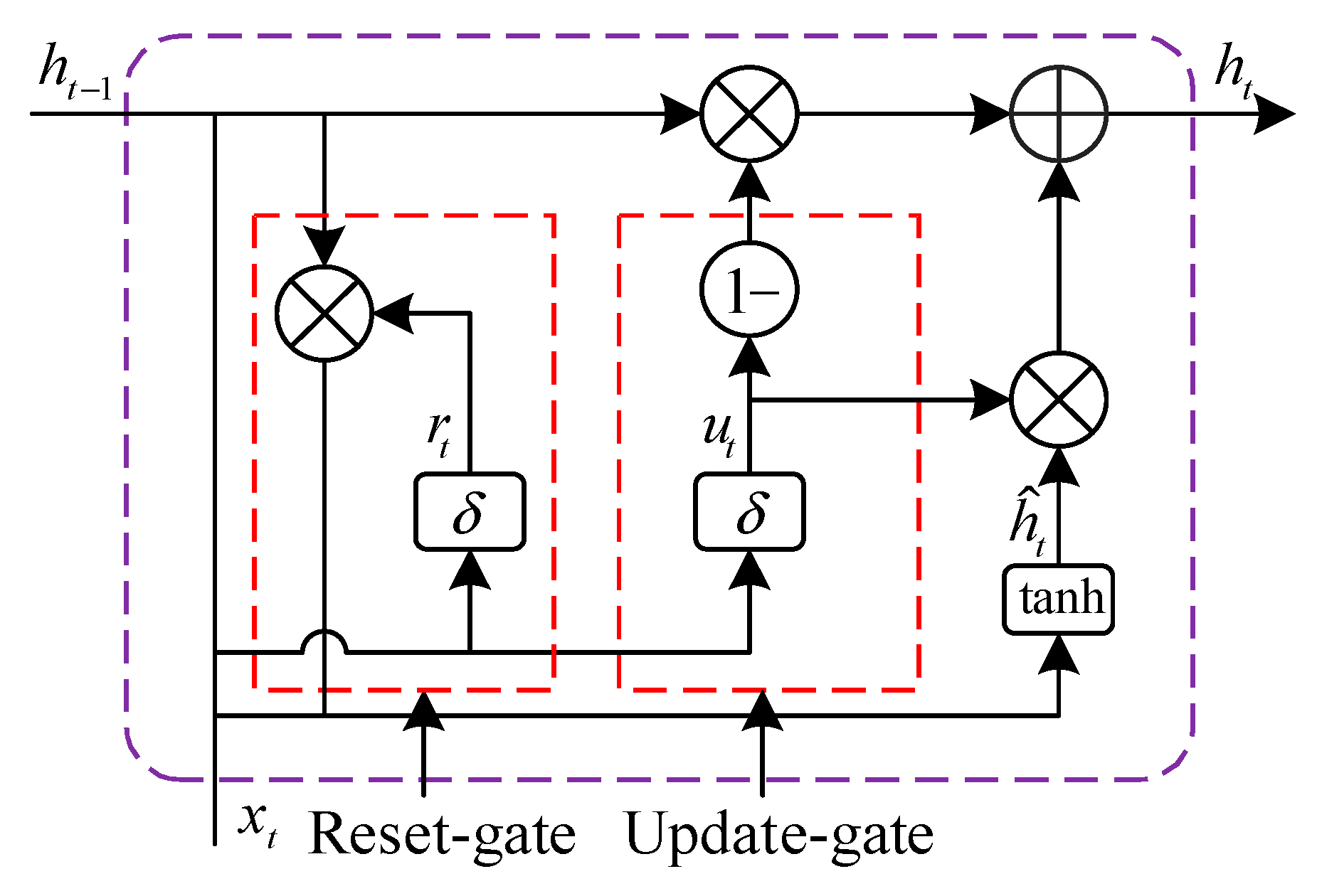
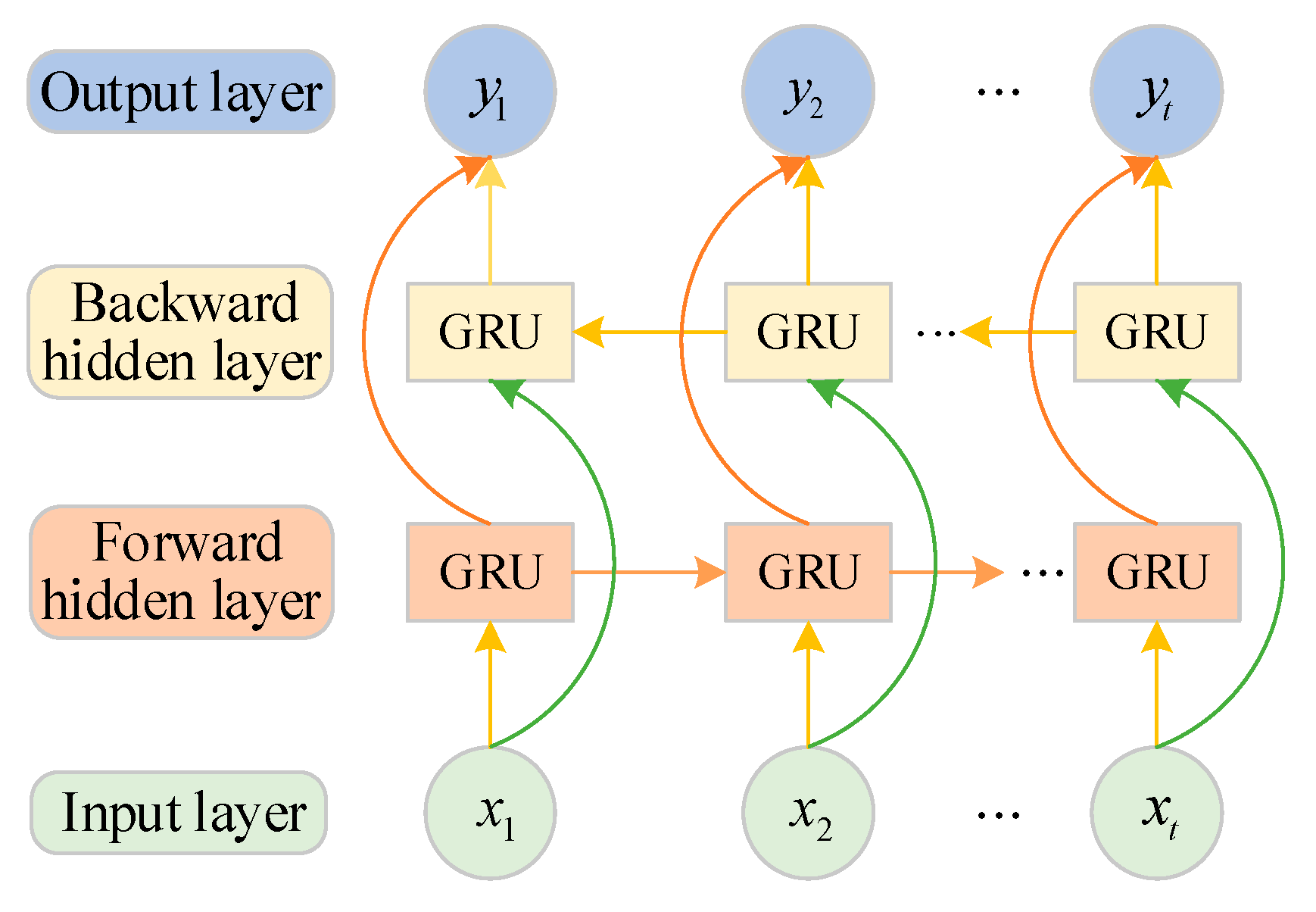

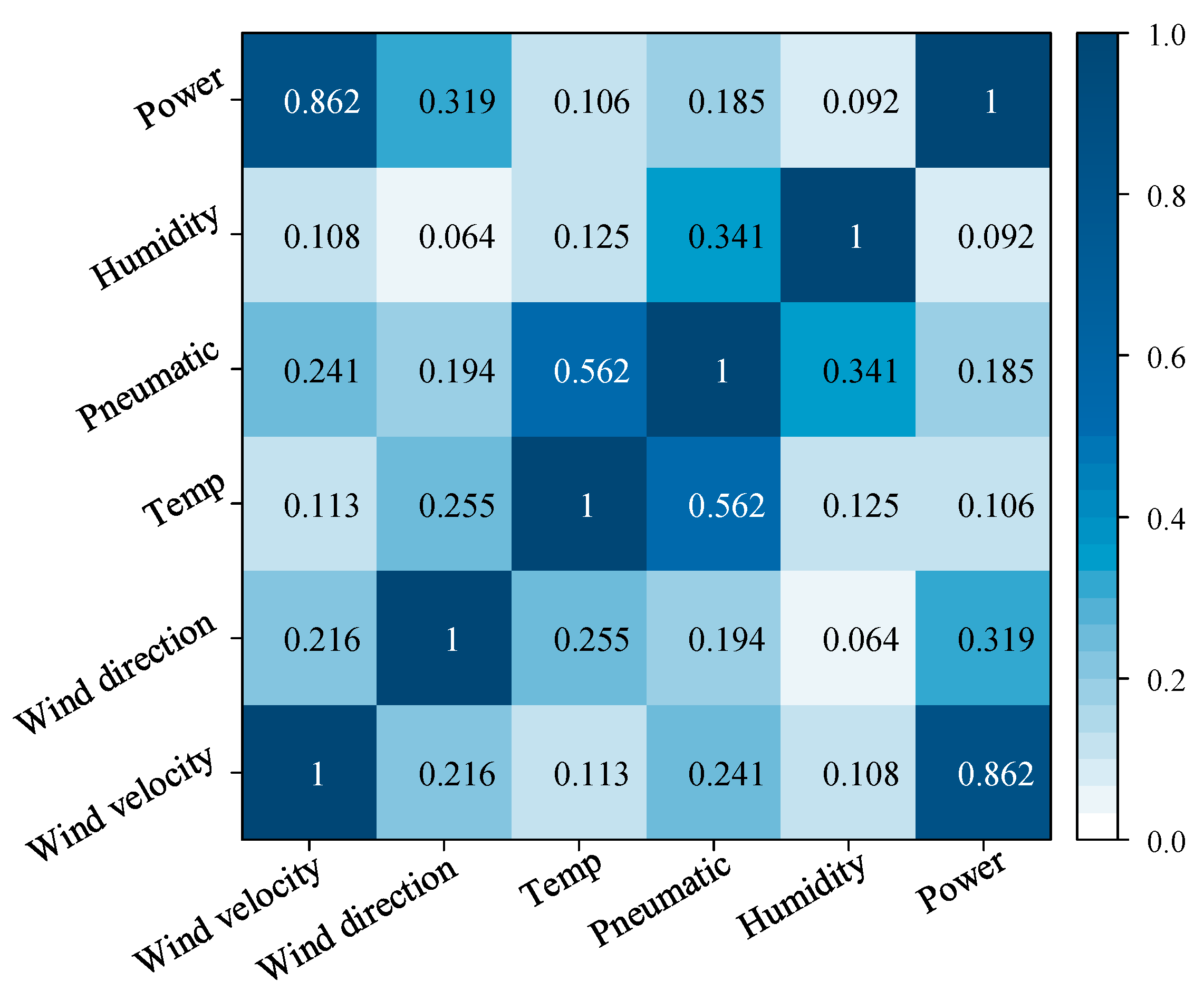
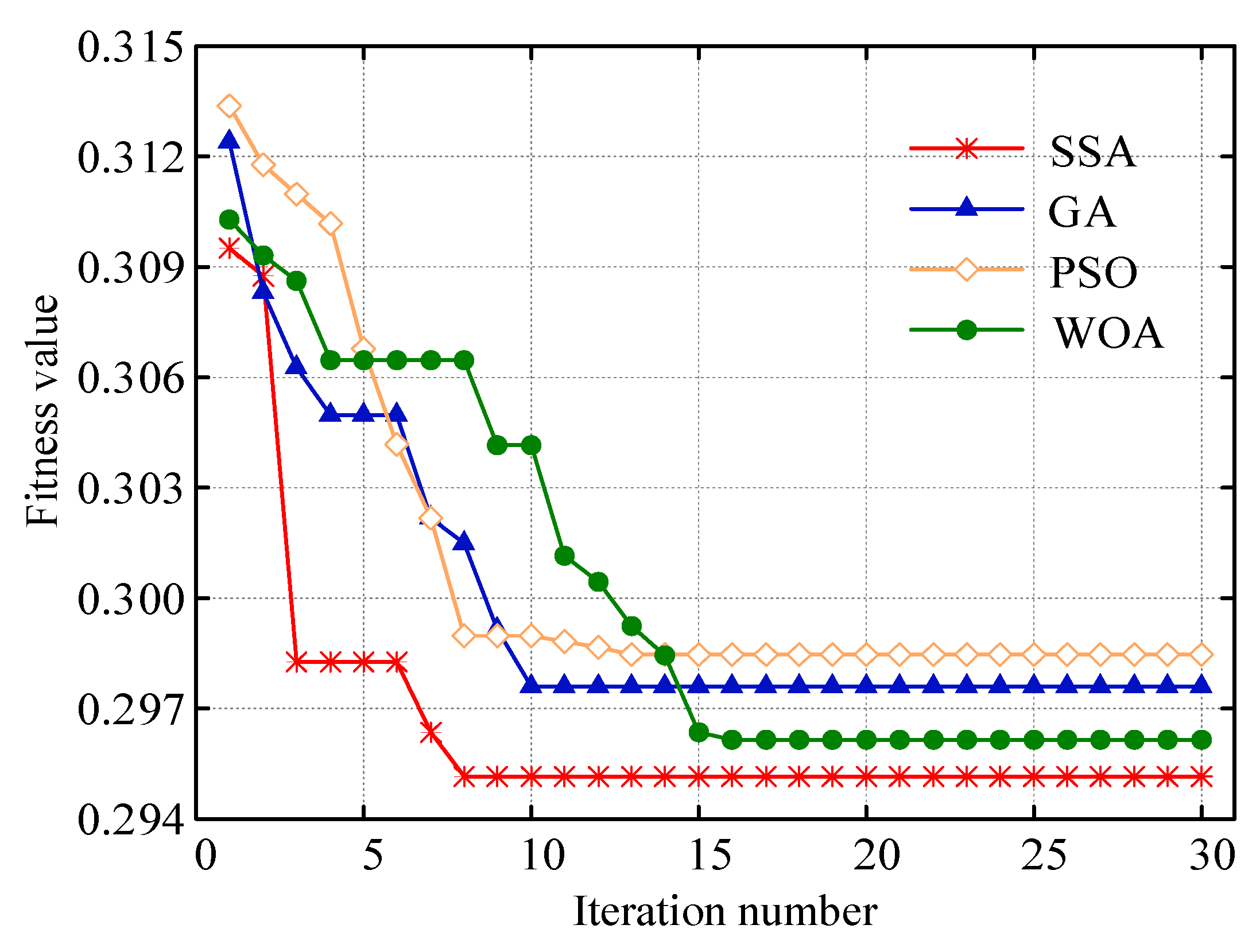

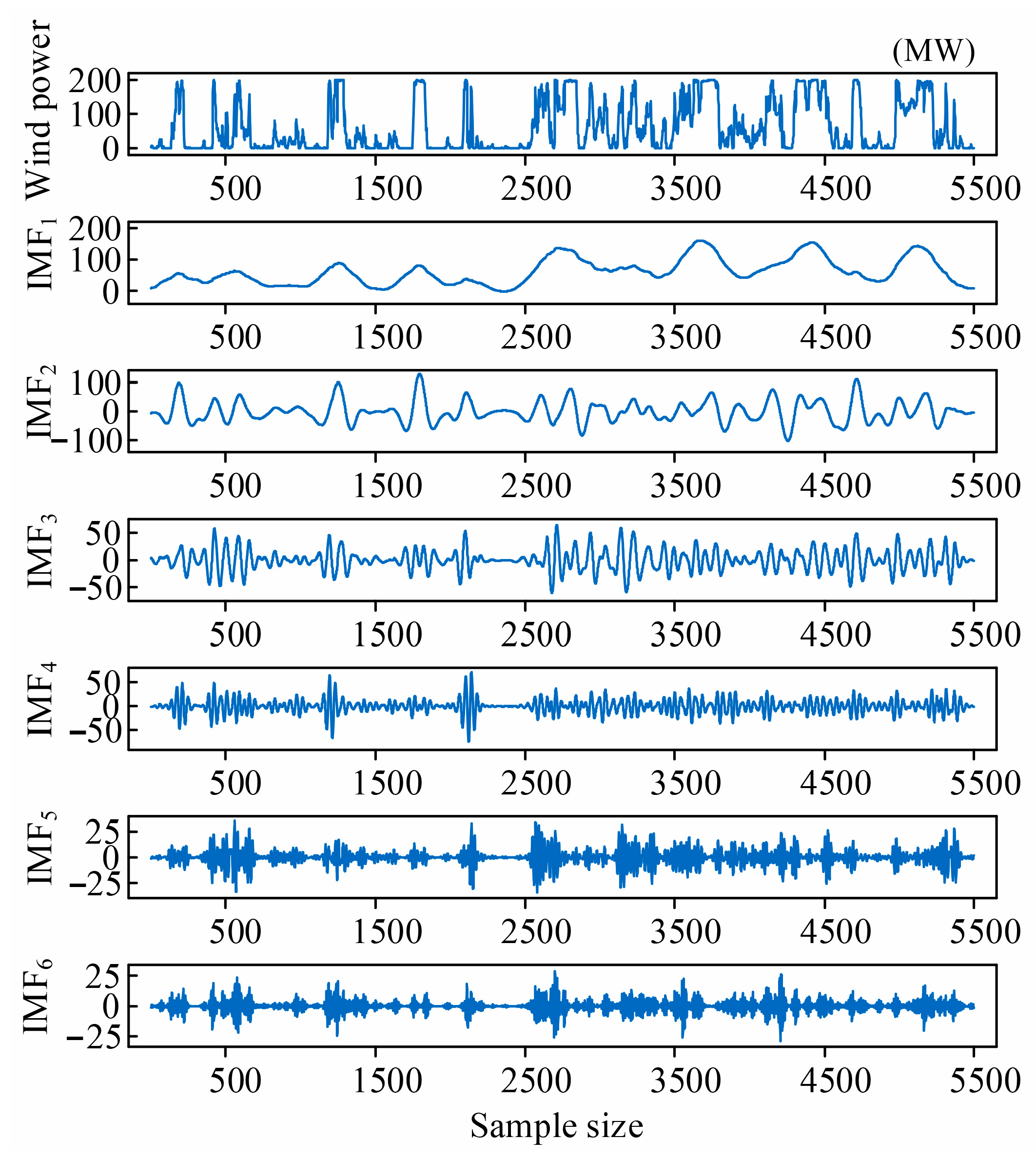
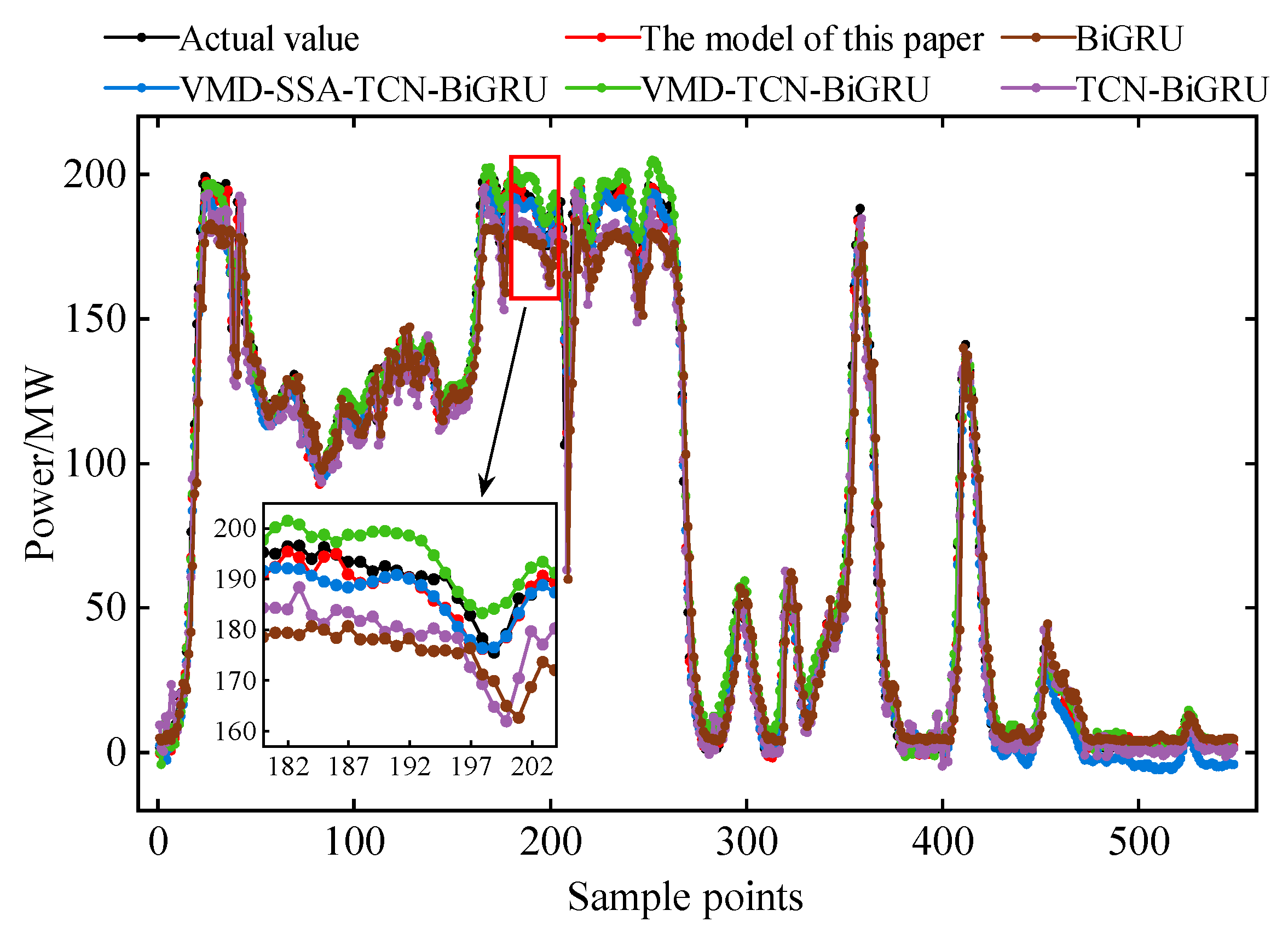
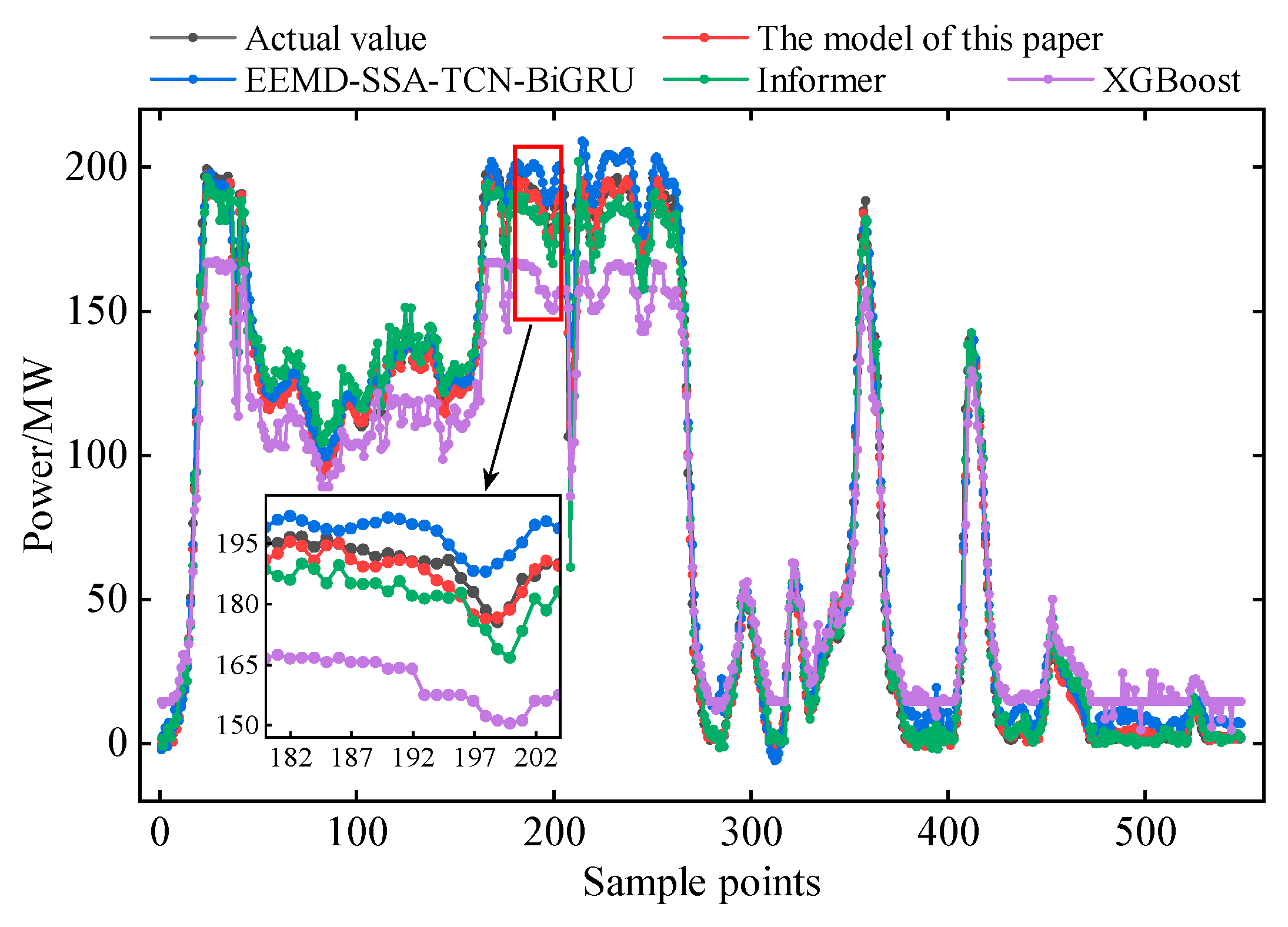
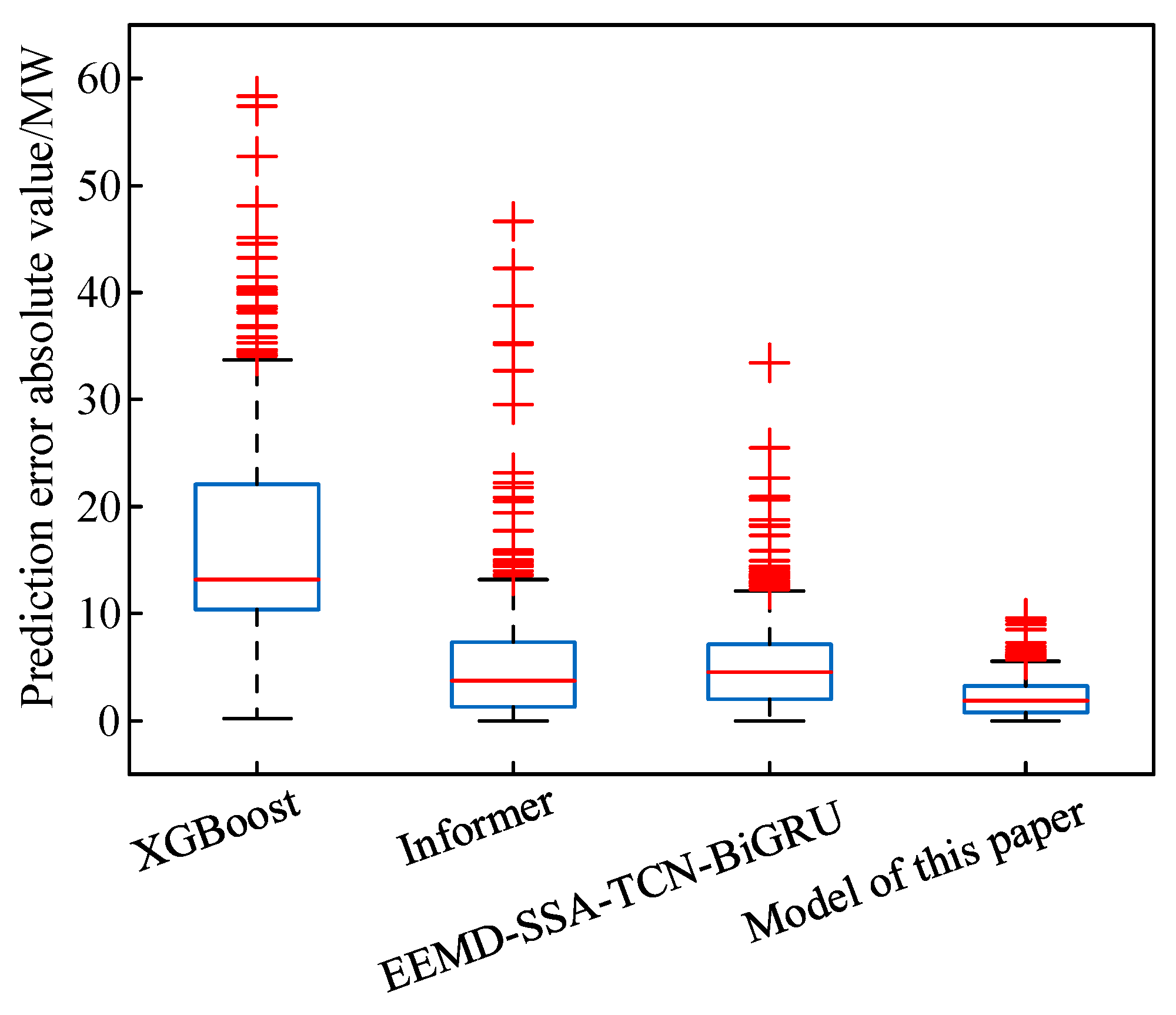
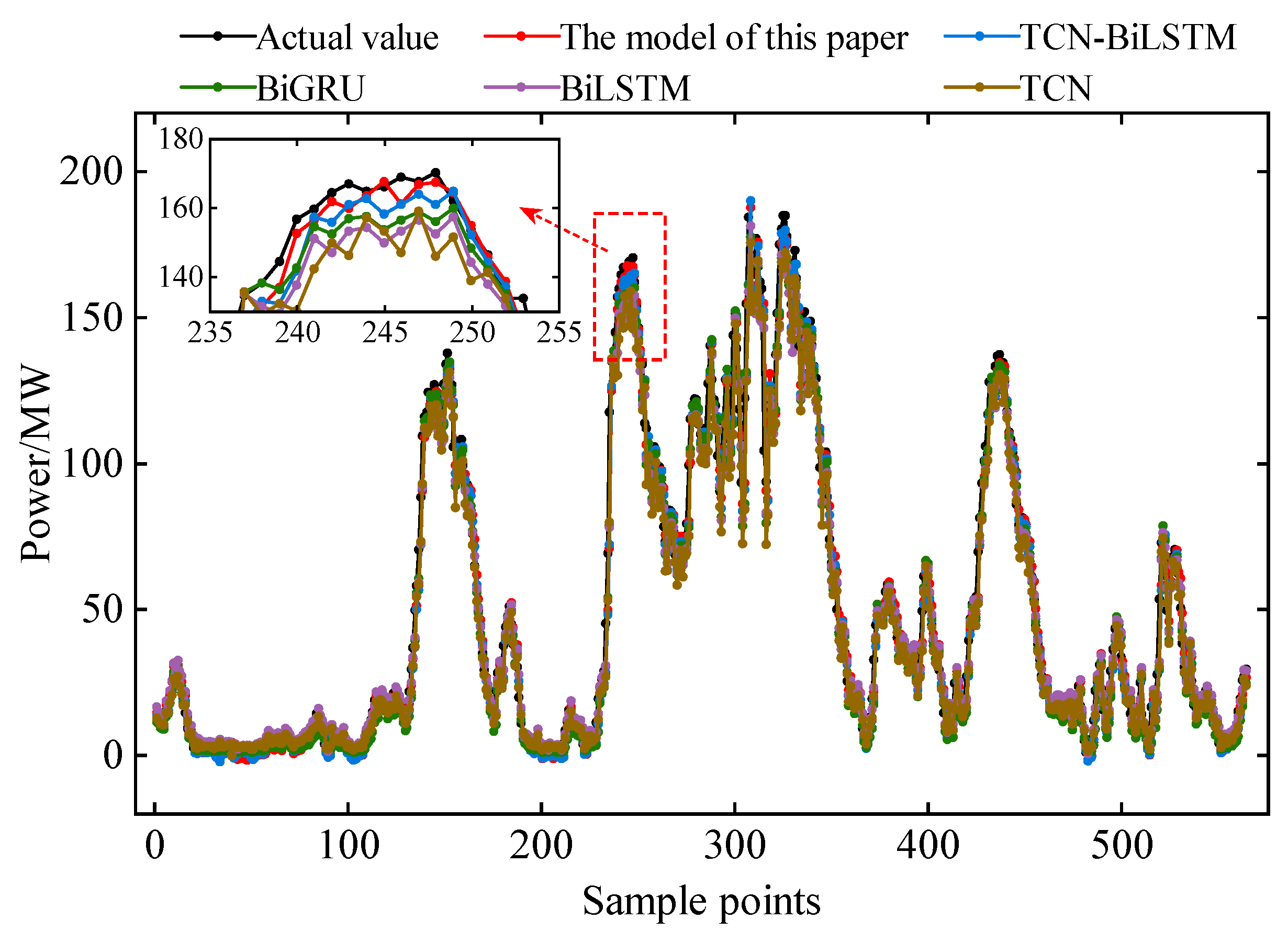
| Parameters | Realm | Value |
|---|---|---|
| Modal number of VMD | [3–10] | 6 |
| Penalty factor for VMD | [100–2500] | 2176 |
| TCN convolutional kernel size | [2–8] | 3 |
| TCN convolutional kernel count | [32–128] | 64 |
| learning rate | [0.001–0.01] | 0.003 |
| Regularization factor | [0.1–0.3] | 0.15 |
| BiGRU neuron count | [30–135] | 128 |
| Models | ERMSE/MW | EMAE/MW | R2 |
|---|---|---|---|
| M4 | 11.084 | 9.137 | 0.97786 |
| M3 | 9.338 | 7.182 | 0.98437 |
| M2 | 6.847 | 5.126 | 0.99061 |
| M1 | 5.325 | 4.142 | 0.99317 |
| The model of this paper | 4.529 | 2.863 | 0.99550 |
| Models | ERMSE/MW | EMAE/MW | R2 |
|---|---|---|---|
| XGBoost | 18.910 | 16.431 | 0.93564 |
| Informer | 7.467 | 5.875 | 0.98947 |
| EEMD-SSA-TCN-BiGRU | 7.166 | 5.682 | 0.98956 |
| The model of this paper | 4.529 | 2.863 | 0.99550 |
| Models | ERMSE/MW | EMAE/MW | R2 |
|---|---|---|---|
| TCN | 8.201 | 5.351 | 0.97044 |
| BiLSTM | 7.903 | 5.119 | 0.97626 |
| BiGRU | 7.659 | 5.195 | 0.97771 |
| TCN-BiLSTM | 7.303 | 4.894 | 0.97973 |
| The model of this paper | 6.793 | 4.345 | 0.98272 |
Disclaimer/Publisher’s Note: The statements, opinions and data contained in all publications are solely those of the individual author(s) and contributor(s) and not of MDPI and/or the editor(s). MDPI and/or the editor(s) disclaim responsibility for any injury to people or property resulting from any ideas, methods, instructions or products referred to in the content. |
© 2025 by the authors. Licensee MDPI, Basel, Switzerland. This article is an open access article distributed under the terms and conditions of the Creative Commons Attribution (CC BY) license (https://creativecommons.org/licenses/by/4.0/).
Share and Cite
Sun, J.; Wei, H.; Chen, C. Ultra-Short-Term Wind Power Prediction with Multi-Scale Feature Extraction Under IVMD. Processes 2025, 13, 2606. https://doi.org/10.3390/pr13082606
Sun J, Wei H, Chen C. Ultra-Short-Term Wind Power Prediction with Multi-Scale Feature Extraction Under IVMD. Processes. 2025; 13(8):2606. https://doi.org/10.3390/pr13082606
Chicago/Turabian StyleSun, Jian, Huakun Wei, and Chuangxin Chen. 2025. "Ultra-Short-Term Wind Power Prediction with Multi-Scale Feature Extraction Under IVMD" Processes 13, no. 8: 2606. https://doi.org/10.3390/pr13082606
APA StyleSun, J., Wei, H., & Chen, C. (2025). Ultra-Short-Term Wind Power Prediction with Multi-Scale Feature Extraction Under IVMD. Processes, 13(8), 2606. https://doi.org/10.3390/pr13082606






